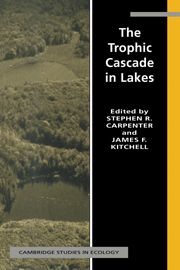Book contents
- Frontmatter
- Contents
- Contributors
- Preface
- 1 Cascading trophic interactions
- 2 Experimental lakes, manipulations and measurements
- 3 Statistical analysis of the ecosystem experiments
- 4 The fish populations
- 5 Fish behavioral and community responses to manipulation
- 6 Roles of fish predation: piscivory and planktivory
- 7 Dynamics of the phantom midge: implications for zooplankton
- 8 Zooplankton community dynamics
- 9 Effects of predators and food supply on diel vertical migration of Daphnia
- 10 Zooplankton biomass and body size
- 11 Phytoplankton community dynamics
- 12 Metalimnetic phytoplankton dynamics
- 13 Primary production and its interactions with nutrients and light transmission
- 14 Heterotrophic microbial processes
- 15 Annual fossil records of food-web manipulation
- 16 Simulation models of the trophic cascade: predictions and evaluations
- 17 Synthesis and new directions
- References
- Index
3 - Statistical analysis of the ecosystem experiments
Published online by Cambridge University Press: 06 August 2010
- Frontmatter
- Contents
- Contributors
- Preface
- 1 Cascading trophic interactions
- 2 Experimental lakes, manipulations and measurements
- 3 Statistical analysis of the ecosystem experiments
- 4 The fish populations
- 5 Fish behavioral and community responses to manipulation
- 6 Roles of fish predation: piscivory and planktivory
- 7 Dynamics of the phantom midge: implications for zooplankton
- 8 Zooplankton community dynamics
- 9 Effects of predators and food supply on diel vertical migration of Daphnia
- 10 Zooplankton biomass and body size
- 11 Phytoplankton community dynamics
- 12 Metalimnetic phytoplankton dynamics
- 13 Primary production and its interactions with nutrients and light transmission
- 14 Heterotrophic microbial processes
- 15 Annual fossil records of food-web manipulation
- 16 Simulation models of the trophic cascade: predictions and evaluations
- 17 Synthesis and new directions
- References
- Index
Summary
Introduction
Experimentation at the ecosystem scale has made important contributions to ecology in general, and limnology in particular, over the past several decades (Likens, 1985; Schindler, 1987). Unlike some alternative approaches, large experiments are appropriately scaled for direct, strong inference about ecosystem dynamics and responses to perturbation (Chapter 1). The main disadvantage of ecosystem experiments is that replication is difficult or impossible (Matson & Carpenter, 1990).
By emphasizing whole lake experiments, we attain the appropriate scale but sacrifice replication. We have compensated for this shortcoming in several ways.
First, some of our manipulations have been strong and sustained ones, in the sense that changes in the independent variates (the fishes) were near the extremes of the natural range, and maintained for many generations of the zooplankton and phytoplankton populations that were the dependent variates (Carpenter, 1989). Such manipulations attempt to cause changes that are large enough to be evident without resorting to statistics, and would be viewed as ecologically significant by most practitioners. Strong sustained manipulations have been used in most ecosystem experiments, with the consequence that subtle responses and interactions are usually not detected (Likens, 1985; Schindler, 1987). For a variety of views on the utility of such ‘sledgehammer’ experiments, see Hurlbert (1984), Schindler (1987), Crowder et al. (1988), Kitchell et al. (1988) and Carpenter (1989).
Second, in some cases we have used data from many reference lakes to test for responses using conventional statistics (Carpenter et al., 1989).
- Type
- Chapter
- Information
- The Trophic Cascade in Lakes , pp. 26 - 42Publisher: Cambridge University PressPrint publication year: 1993
- 6
- Cited by



